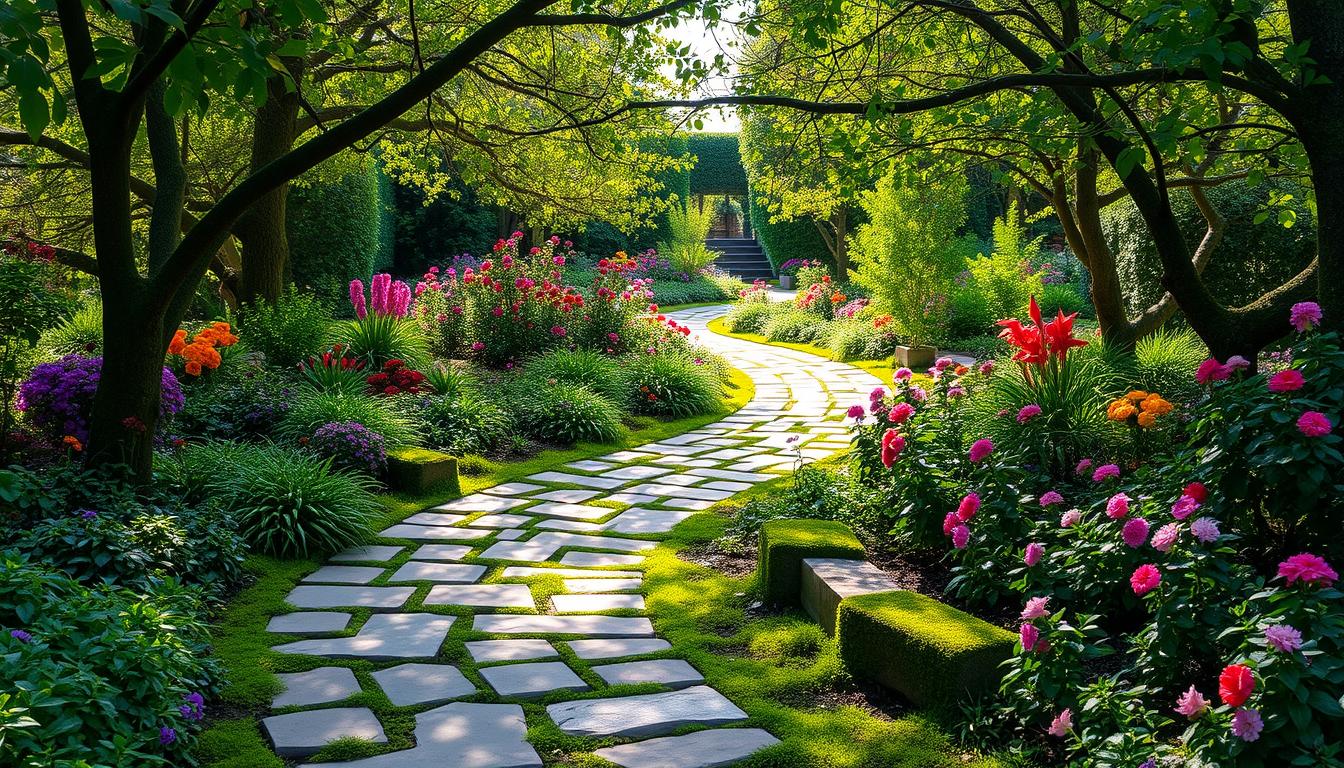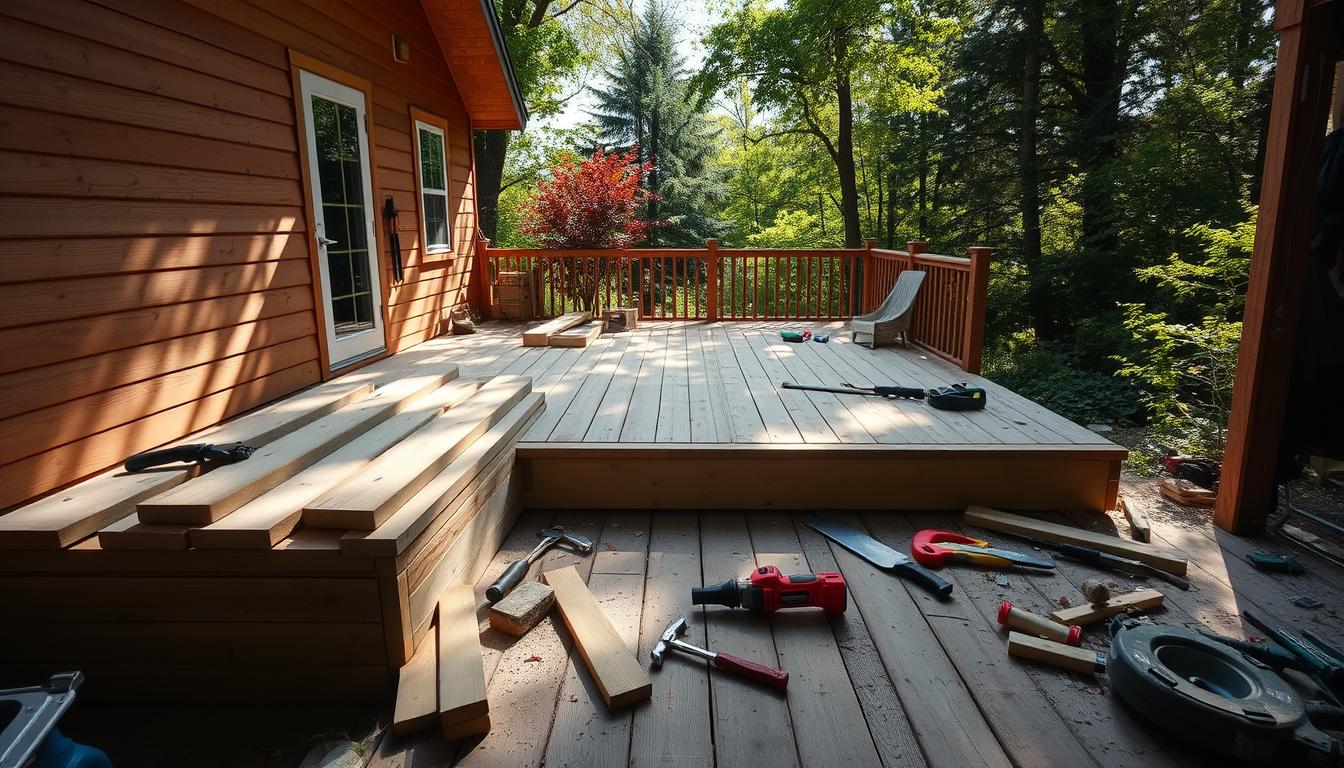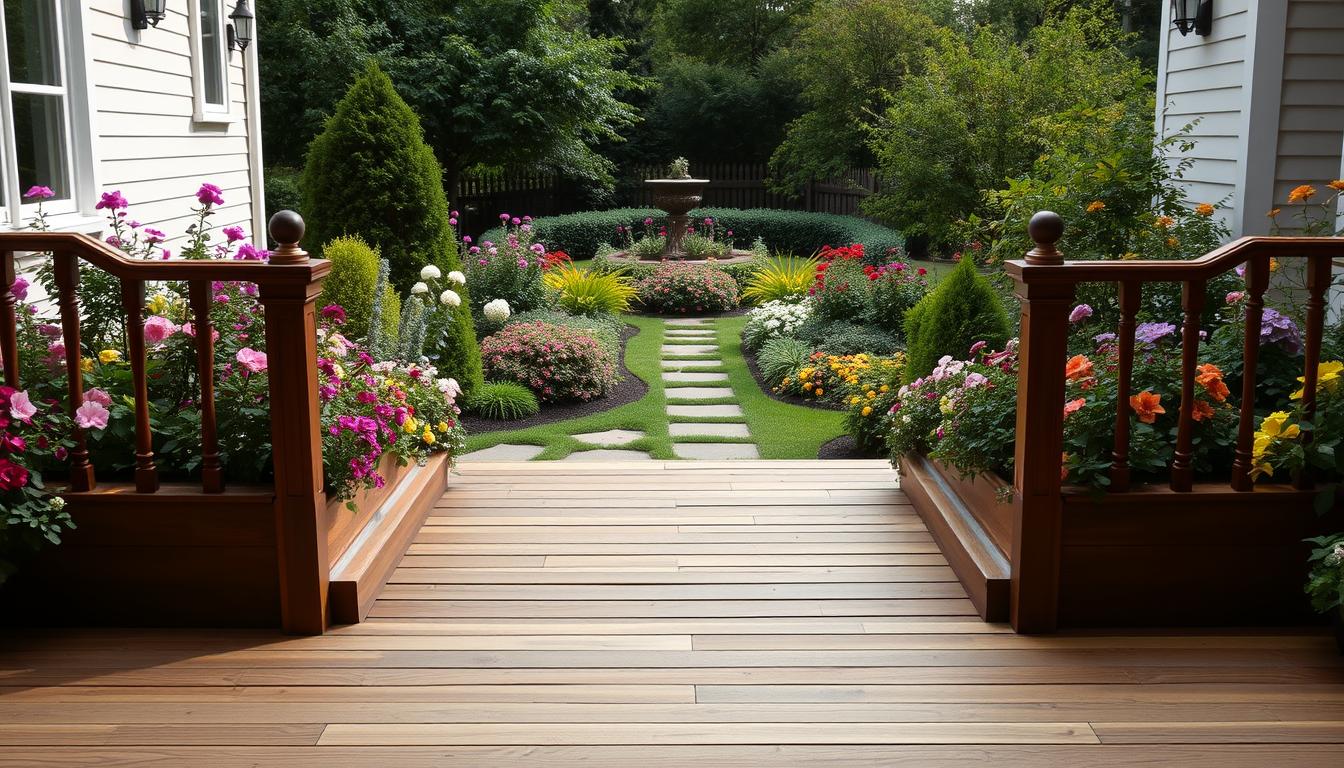A well-designed garden path can elevate your outdoor space’s aesthetic, ensure safe and easy access, and foster a sense of movement. When designing pathways, it’s vital to consider the landscape, climate, and path’s purpose. Various materials can be used for garden walkways, each offering unique benefits.
Designing a beautiful and practical garden path is key in landscape design. Choosing the right materials and aligning the path with the landscape can result in a visually stunning and functional pathway. Pathway design and garden walkways are intertwined, influenced by climate and intended use. This approach ensures your garden path meets your needs and beautifies your outdoor area.
Introduction to Garden Path Creation
Whether aiming for a formal garden walkway or a rustic, natural path, numerous options exist. By exploring different materials and methods, you can craft a path that’s both attractive and practical. Garden walkways and pathway design are crucial in outdoor space creation. Proper planning and design of your path can make your space enjoyable and functional.
Key Takeaways
- Consider the overall landscape design when creating your garden path
- Choose materials that are suitable for your climate and intended use
- Garden walkways can be made from a variety of materials
- Pathway design is an important consideration in landscape design
- Creating a functional and beautiful garden path can enhance your outdoor space
- Garden paths can create a sense of flow and movement in your outdoor space
Understanding the Role of Garden Paths in Landscape Design
Garden paths are vital in landscape design, offering both utility and beauty. A well-crafted garden path enhances the garden’s flow and movement. It also ensures a safe, accessible path for strolling. The selection of path materials greatly influences the garden’s ambiance, with choices from gravel and stone to brick and concrete.
In designing a garden path, the broader landscape design must be considered. This includes the plants, trees, and other elements that will be part of the garden. Such considerations help in creating a unified, aesthetically pleasing outdoor space. Key aspects of garden path design include:
- Defining different garden areas, like seating spots or vegetable gardens
- Designing paths that guide the eye through curves and bends
- Selecting path materials that match the garden’s surroundings and architecture
A well-designed garden path significantly enhances the garden’s beauty, adding visual appeal and depth. By focusing on the role of garden paths in landscape design, homeowners can craft a space that is both beautiful and practical. This space can greatly improve their quality of life.
Essential Planning Considerations for Your Garden Path
Designing and building a garden path requires careful consideration of several key factors. Garden planning is essential to ensure your path is both functional and visually appealing. The terrain and slope of your garden are critical, as they determine the suitable walking surfaces.
A well-designed garden path should blend seamlessly with the garden’s overall layout. This includes the placement of plants, trees, and other features. The choice of walking surfaces, such as concrete, asphalt, or natural stone, significantly affects safety and accessibility. For instance, natural stone offers a beautiful, durable option, while concrete or asphalt might be better for areas with heavy foot traffic.
- Assessing the intended use of the path, such as for walking, biking, or wheelchair access
- Determining the best materials for the path, based on factors such as durability, maintenance, and cost
- Considering the overall aesthetic of the garden, including the style and color of the path, as well as any surrounding features
By thoughtfully considering these factors and integrating them into your garden planning, you can craft a beautiful, functional garden path. The right walking surfaces are crucial for creating a safe, enjoyable experience for all users.
Popular Types of Garden Paths for Every Style
A well-designed garden path can transform your outdoor space. The right pathway design enhances your garden’s look and provides a safe route. With many types available, choosing one that fits your style and garden design is crucial.
Popular pathway designs include formal walkways and rustic paths. Formal paths, made from brick or stone, offer a traditional elegance. They feature straight lines and symmetrical patterns. In contrast, rustic paths use materials like gravel or wood chips, adding warmth and coziness.
Formal Garden Walkways
Formal garden walkways are ideal for those seeking elegance. These paths are crafted from high-quality materials like brick or stone. They often display intricate designs, enhancing your garden’s sophistication.
Rustic and Natural Pathways
Rustic and natural pathways suit those preferring a relaxed garden atmosphere. Made from materials like gravel or wood chips, these paths have organic and curved lines. They offer a cozy feel.
Modern Path Designs
Modern path designs bring a contemporary flair. Using materials like concrete or metal, these paths feature bold patterns. They add drama and visual interest to your garden.
Choosing the right garden path involves considering your style and garden design. A pathway that complements your garden creates harmony. This enhances your outdoor experience.
| Pathway Type | Materials | Design Features |
|---|---|---|
| Formal Garden Walkways | Brick, stone | Straight lines, symmetrical patterns |
| Rustic and Natural Pathways | Gravel, wood chips, natural stone | Organic and curved lines |
| Modern Path Designs | Concrete, metal, glass | Bold and geometric patterns |
Choosing the Right Materials for Your Path
Creating stunning garden walkways requires careful selection of path materials. Each material has its own strengths in durability, slip-resistance, and visual appeal. Gravel and stone, for example, are favored for their natural beauty and texture.
It’s vital to consider the materials’ durability and upkeep needs. Also, think about how the path will complement your landscape design. A well-planned garden walkway can elevate the beauty of your surroundings, guiding visitors through your outdoor space.
These options allow for a wide range of styles, from sophisticated to rustic. You can achieve a look that suits your taste and enhances your garden’s ambiance.
Your choice of path materials should align with your preferences, budget, and the path’s purpose. By evaluating factors like climate, foot traffic, and intended use, you can find the ideal materials. This will ensure your garden walkways are both beautiful and practical.
Natural Stone Options for Garden Walkways
Natural stone is a top pick for garden walkways, blending durability, low-maintenance, and beauty. It’s a key element in enhancing a garden’s landscape design. Choosing the right stone is crucial, as different types offer unique textures, colors, and patterns.
For walking surfaces, natural stone provides a smooth, stable path. Slate, flagstone, granite, and limestone are among the favorites. They allow for a wide range of styles, from modern to traditional.
- Durability: It withstands wear and tear, ensuring a long-lasting path.
- Low-maintenance: Natural stone is easy to care for, resistant to stains, and simple to clean.
- Aesthetic appeal: It brings elegance and sophistication to any garden, making it a favorite for those seeking beauty outdoors.
In summary, natural stone is an excellent choice for garden walkways. It combines functionality, durability, and beauty, enhancing a garden’s landscape design and walking surfaces.
Manufactured Materials for Durable Paths
In garden planning, the choice of path materials is key. Concrete pavers and brick stand out for their durability and ease of maintenance. They are often more budget-friendly than natural stone and can mimic its aesthetic.
For outdoor navigation, these materials ensure a smooth path. Climate, traffic, and intended use are critical in material selection. They impact the path’s functionality and longevity.
Popular options for garden paths include:
- Concrete pavers
- Brick
- Asphalt
These materials allow for a wide range of styles, from modern to traditional.
By aligning your garden planning and navigation needs, you can select the ideal materials. This will help create a stunning and practical outdoor area.
| Material | Benefits | Drawbacks |
|---|---|---|
| Concrete pavers | Durable, low-maintenance, affordable | Can be prone to cracking |
| Brick | Classic look, durable, easy to install | Can be expensive, heavy |
| Asphalt | Affordable, easy to install, smooth surface | Can be prone to cracking, not eco-friendly |
Step-by-Step Path Installation Methods
Installing a garden path requires careful planning and execution. It must be safe, functional, and visually appealing. A well-designed pathway can greatly enhance your garden’s look and feel. To achieve this, a step-by-step approach to path installation is essential.
Before starting, it’s crucial to prepare the ground. This involves clearing the area, leveling the terrain, and laying down a base material. A solid foundation is key to ensuring your garden walkways remain stable and secure.
Ground Preparation Techniques
Some key techniques for ground preparation include:
- Clearing the area of debris and vegetation
- Leveling the terrain to ensure evenness
- Laying down a base material, such as gravel or sand
Layout and Design Implementation
After preparing the ground, it’s time to lay out the path design. Measure and mark the path, then implement the design using the selected materials. Choose materials that complement the surrounding landscape to achieve the desired aesthetic.
Professional Installation Tips
To ensure your garden walkways are installed correctly, follow professional installation tips. Use high-quality materials, follow proper installation procedures, and maintain the path regularly. This way, you’ll enjoy your beautifully designed garden walkways for years.
Incorporating Lighting Along Your Garden Path
Lighting can significantly enhance the safety, functionality, and beauty of your garden path. When choosing lighting, consider the path materials and landscape design. This ensures you pick the best lighting for your garden.
There are various lighting options, including solar-powered lights, low-voltage systems, and traditional hardwired setups. Each has its own benefits and drawbacks. For instance, solar-powered lights are energy-efficient and simple to install. On the other hand, low-voltage systems offer flexibility and can be moved easily.
Solar-Powered Options
Solar-powered lights are ideal for garden paths. They harness sunlight, eliminating the need for wiring or electricity. This makes them straightforward to install and maintain. Some popular choices include:
- Solar-powered lanterns
- Solar-powered spotlights
- Solar-powered string lights
Strategic Placement Tips
Strategic lighting placement can greatly enhance your garden’s look and feel. Place lights along the path’s edges to create depth and dimension. You can also use them to highlight features like water fountains or statues.
By adding lighting to your garden path, you create a beautiful, functional outdoor space for day and night enjoyment. Remember to align your lighting choices with your path materials and landscape design.
| Lighting Option | Advantages | Disadvantages |
|---|---|---|
| Solar-Powered Lights | Energy-efficient, easy to install | Dependent on sunlight, may not be as bright as other options |
| Low-Voltage Lighting Systems | Flexible, easy to relocate | Requires wiring, may be more expensive |
Maintenance and Care Tips for Garden Paths
Regular maintenance is key to keeping your garden path safe, functional, and looking great. When it comes to walking surfaces, consider the garden planning to avoid damage and extend the path’s life. This means keeping the path clear of debris, maintaining plants and trees, and ensuring it’s safe and easy to access.
To keep your garden path in top shape, start by checking the walking surfaces for damage or wear. Look for cracks, unevenness, or erosion signs. Make a list of tasks to keep your path in good condition, such as:
- Regular cleaning to prevent dirt and debris buildup
- Inspecting the path for damage or wear
- Maintaining surrounding plants and trees to prevent overgrowth
By adding these maintenance tasks to your garden planning, you can prevent damage and extend your path’s life. Remember to also consider the walking surfaces when maintaining your path. This ensures it remains safe and accessible.
By following these tips, you can keep your garden path looking its best. Regular maintenance and care will prevent damage and extend the path’s life. This makes it a valuable investment for your home and garden.
Solving Common Garden Path Problems
Outdoor navigation is greatly enhanced by a well-designed pathway. Yet, common problems can arise, impacting both the look and function of your outdoor space. It’s vital to focus on pathway design and its integration with the landscape.
Ensuring the path is safe and accessible is crucial. Implementing drainage solutions like French drains or permeable pavers can help. Regular maintenance, including weeding and pruning, keeps the path clear and functional.
Drainage Issues and Solutions
Drainage problems can make paths slippery and waterlogged. Using materials like gravel or decomposed granite can improve water flow. A slight incline or slope can also direct water away from the path.
Weed Control Methods
Weed control is key to a well-kept garden path. A weed barrier fabric or natural weed killers like vinegar can be effective. Regularly checking and removing weeds prevents them from spreading.
Repair and Replacement Strategies
When paths are damaged, repair or replacement may be needed. This could involve re-grading, re-laying pavers, or applying a new layer. By focusing on pathway design and navigation, you can create a beautiful and functional path.
| Problem | Solution |
|---|---|
| Drainage issues | Install French drains or use permeable pavers |
| Weed control | Use weed barrier fabric or natural weed killers |
| Path damage | Re-grade surface, re-lay pavers, or apply new material |
Conclusion: Creating Your Perfect Garden Path
Embarking on the journey to create your ideal garden path opens up a world of design and practicality. By choosing the right garden walkways and path materials, you can turn your outdoor area into a serene oasis. This transformation is not just about aesthetics; it’s about creating a space that feels harmonious with nature.
Success in garden path design hinges on careful planning and execution. It’s crucial to consider the path’s style, function, and upkeep needs. This ensures it blends seamlessly with its surroundings. With a thoughtful approach, your garden path will become a stunning and functional element, elevating your outdoor space.




